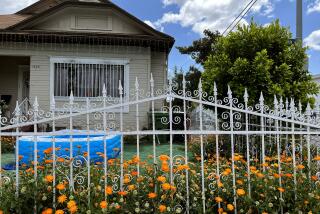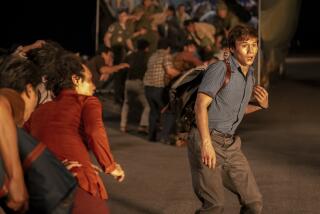Prisoner Exchange at Border a Stiff, Ritualistic Affair : Mine Field Near ‘Friendship Gate’ Symbol of China-Vietnam Tension
- Share via
FRIENDSHIP GATE, Vietnam-China Border — Vietnam has a few good roads: Highway One, for instance, in stretches, but not the section here at the border. The last two miles of it are an asphalt footpath, through a mine field, to Friendship Gate.
The area is scarred by war and bristling with military force, a diorama of the fitful relations between the two one-time allies.
During the Vietnam War, Chinese and Soviet arms and other supplies moved down Highway One and a parallel railway into North Vietnam. U.S. pilots bombed both, right up to the frontier, but never shut them down.
In February, 1979, four years after the war ended, the Chinese did. Attempting to punish Vietnam for its invasion of Cambodia, which had been ruled by China’s Khmer Rouge allies, Chinese troops drove across the border on a broad front.
After a month of hard fighting, the Chinese withdrew, but no cargo has moved since on the northern part of the railway. Reeds have grown up through the skeletons of two abandoned freight cars. And north of the shelled-out village of Dong Dang, vines and undergrowth have crept over the highway, leaving only the footpath up to Friendship Pass.
There, a whitewashed line marks the frontier and the Kilometer Zero point on the highway, which extends south to the Vietnamese capital of Hanoi and beyond to its terminus in Ho Chi Minh City (Saigon).
In August, a group of foreign journalists were escorted north along the highway to observe a prisoner exchange between the Vietnamese and Chinese.
Since 1979, the Sino-Vietnamese conflict has stuttered militarily but not politically. The Vietnamese occupation of Cambodia remains the sticking point preventing better relations.
Troops Along Frontier
Both sides have an estimated half a million men stationed along the frontier, and there is an occasional artillery exchange, particularly on the front northwest of Friendship Gate. In January, in the sharpest outbreak since the Chinese invasion, three days of fighting reportedly resulted in hundreds of casualties.
Currently, according to Gen. Tran Cong Man, editor of the Vietnamese army newspaper Quan Doi Nhan Dan, “the situation is not very strained, no big battles.”
Most of the trouble, he told the reporters at his offices in Hanoi, takes place on the border of the Vietnamese province of Ha Tuyen.
“Both armies are ready for a fight, alert,” he said.
The last major shelling in the Friendship Gate area took place more than three years ago, from early April to mid-May, 1984, said a Vietnamese officer who was present for the prisoner exchange.
“The Chinese fired more than 1,000 mortar and artillery rounds,” he said. He insisted that the Vietnamese did not return the fire.
Friendship Gate, as the site of the only contact between the two forces along the winding border, has a special significance that may prevent more fighting. Including the recent exchange, the Vietnamese say, they have returned 450 Chinese “intruders” here since 1979. In return, 168 Vietnamese have been handed over by the Chinese. There have been 21 separate prisoner exchanges.
Invariably, each side says that its men were captured in their own territory and were merely innocent farmers or fishermen, not military.
Red Cross Escort
All the exchanges are carried out under Red Cross auspices. The contingent of journalists, soldiers and provincial officials that set out recently along the path from Dong Dang was preceded by a Red Cross flag and stretcher bearers in white coats and caps.
The path, which begins directly outside the ruined houses of the village, is marked by whitewashed lines and an occasional white skull and crossbones daubed on the asphalt, denoting the mine field.
“Stay in single file and stay on the path,” the marchers were warned.
Here and there beside the three-mile route, morning glories bloomed alongside a few menacing, olive-drab anti-tank mines that had been dug out of the path to permit safe passage for that morning’s exchange. One remained in the pathway itself, its pressure fuse removed. On a nearby hill, a Chinese radar dish stood motionless.
Several times the asphalt disappeared altogether and the path dwindled to a narrow dirt walkway. At its end, where the path widened to about eight feet, a media event awaited.
On the Vietnamese side of the border stood an honor guard of eight soldiers in pressed fatigues and billed caps. Across the white line was a far larger Chinese contingent, about 80, dressed in smarter, darker green uniforms. The soldiers lined the sides of what, on Chinese territory, is a two-lane road. The Chinese carried new AK-47 rifles, their wooden stocks polished, the metal glistening. The Vietnamese honor guards carried the same type of weapons, but their stocks were dull and showed much use.
As the 10 foreign journalists--five Americans, three Japanese, a Swiss and a Cuban--pressed up to the border for photographs, a Chinese officer gave a signal and up marched a horde of Chinese journalists, wearing pink ribbons for identification. The unsmiling Chinese busily photographed the foreigners, who snapped back in turn. All attempts to strike up a conversation were turned aside.
Having numerically won the battle of the journalists, the Chinese switched to close-order drill, changing their honor guard in a polished maneuver. The Vietnamese responded with a guard rotation of boot-camp quality.
The preliminaries concluded, Vietnamese officers, wearing green collar flashes, and the Chinese, wearing red, approached the line, exchanged handshakes and ritualistically denounced each other’s captives as spies and intruders. They conceded, however, that their respective foreign ministries had agreed to the exchange, so they shook hands again and got started.
The 14 Vietnamese captives of the Chinese came across the line first, one by one, dressed in dark blue shirts and pants and matching Mao-style caps. One, with a bullet wound in the leg, was carried across on a stretcher.
The others appeared bewildered and disoriented but seemed in good condition. Among them was a 63-year-old man. Across the line, each was briefly embraced by an officer who said, “You’re in Vietnam.”
The Vietnamese returned 18 Chinese, who they said had been captured at sea off the northern coast and were accused of spying and violating Vietnamese waters. Singly, escorted by a Vietnamese soldier on each arm, they were led to the line and met by a brief embrace on the Chinese side, then brusquely moved off.
Angry Prisoner
The Chinese captives were dressed Vietnamese style: white short-sleeved shirts, khaki pants and green pith helmets. One Chinese prisoner hurled his helmet angrily to the ground once he had crossed the line.
The ceremony completed, the two sides promptly disengaged. The Chinese headed north and the Vietnamese south, down the path to Dong Dang. If there were any fortifications on the border, they were hidden by the jungle. Presumably, once the contingent passed, the mines were replaced in the path.
The journalists were allowed no contact with the returned Vietnamese, who were loaded on a bus at the village, the end of the road.
The drive to the border, 65 miles away, had begun the day before, in heavy truck and bicycle traffic on Highway One, in the northeast suburbs of Hanoi. From there, the road reaches north through the rice paddies of the Red River Valley.
Passing a railroad junction town in the valley, a young escort recalled the Vietnam War years.
“They sent the children out of Hanoi,” he said. “I stayed with a farm family about nine miles from here. In the afternoons, we boys used to sit in the fields and watch the Americans bomb the railroad yards.”
Moving out of the valley, the highway runs into hill country, past fields of tobacco, corn and cassava. With each mile, the pavement gets rougher. Climbing into the mountains, the home of the Nung and Dao tribal people, the driver jerked the Russian sedan around potholes and boulders. The destination was the city of Lang Son, the southernmost point of the 1979 Chinese invasion.
Lang Son was heavily damaged in the fighting, about three-quarters destroyed, according to the escort, when the Chinese planted explosives as they withdrew three days after battling their way into the town. About 500 civilians were killed and 800 taken captive, the escort said.
Now Lang Son is rebuilding. The population is 50,000, many returning only recently from their flight of 1979. New homes have been built with the rubble of invasion. But life is not normal. South of town, covered in canvas, five tanks were parked by the side of the highway. A leveled-off hill provided a fire base for a battery of Russian-made 130-millimeter guns.
On the northern outskirts, the highway crosses the Ky Cung bridge, restored only last May to replace a ferry that had been in operation since the 1979 invasion.
The area north of Lang Son is a military zone--no photographs--for the border is just seven miles away, 11 by the winding road. Off-duty Vietnamese soldiers trudge along the road near Dong Dang, where Highway One narrows to the footpath to Friendship Gate. And both the Vietnamese and Chinese, for some reason, still call it that.
More to Read
Sign up for Essential California
The most important California stories and recommendations in your inbox every morning.
You may occasionally receive promotional content from the Los Angeles Times.










